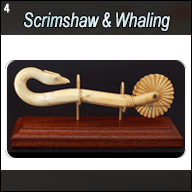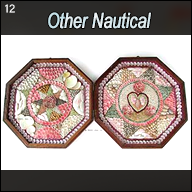20. Canes & Walking Sticks
Prices in U.S. Dollars are in GREEN
NOTE: A recent California statute makes it illegal in that state to "possess with the intent to sell" many forms of srimshaw, elephant ivory and other endangered species products, without regard to the age of the object. The exception to this is walrus. Accordingly, the items listed below are not available to California residents. However West Sea Company still maintains its long-time affiliate in the state of Massachusetts where these antique items are currently stored and sold legally.
 |
20.00/21.61 RARE TELESCOPE CANE. Amazing, very early 1800’s English gentleman’s walking stick with the most unusual dual function of being a long distance telescope! This ingenious device is all brass in its traditional black leather covering. It has a large turned ivory knob and brass ferrule. Both the knob and the ferrule are threaded. Unscrewing them reveals a genuine, tapered single draw telescope of the “spyglass” type. The draw on the ferrule end is engraved in fancy script with the makers “G. & W Proctor, London.” The doublet objective lens measures 1 1/8 inches in diameter. In combination with the classic 4 element lens system it provides a highly magnified upright image free of chromatic distortion. The telescope itself measures 25 ½ inches long closed and 31 inches extended to infinity. The lovely knob is 2 5/8 inches in diameter and 1 ½ inches tall. It is connected to a threaded brass band ¼ inch thick and 1 ¼ inches in diameter. Such a configuration, which required frequent opening and closing, is still in remarkable original condition. The fittings are tight, sturdy and fully functional. A true rarity, both as a telescope and a cane! 1095 George and William Proctor were listed as opticians in London from 1790 - 1830. (Gloria Clifton, “Directory of British Scientific Instrument Makers 1550 – 1851,” 1995, The National Maritime Museum, Philip Wilson Publishers, London.) |
 |
 |
| components | knob |
 |
 |
| ocular | objective |
 |
| maker |
20.98 TRENCH ART WALKING STICK. Unique, one-of-a-kind World War I American dough boy folk art in the form of a usable walking cane of the era. This hand-made piece was fabricated from battlefield materials and an exotic wood. The handle is a WWI bullet which is marked on the bottom of the shell casing “WRA CO. U.S.A. 30.” The lovely tapering cane shaft is made from exotic “Kingwood” and is complete with its original brass ferrule at the tip. 35 ½ inches long. The handle measures 3 ¼ inches wide (length of bullet) and the top is 7/8 inches in diameter. Excellent original condition showing its 100+ years of age with no abuse. A rare melding of militaria and cane collecting! 349 The iconic Winchester Repeating Arms Company was a prominent American manufacturer of firearms and ammunition on the heels of the Civil War. Established in 1866 by Oliver Winchester in New Haven, Connecticut, it was a major supplier of guns and ammunition to the American military in both the Spanish-American and First World Wars. The company went into receivership in 1931 when it was purchased by the Western Cartridge Company and ultimately the Olin Corporation. |
 |
 |
| handle | ferrule |
 |
| wra |
 |
20.97 DAGGER CANE. Elegant gentleman’s walking stick with the dual function of being a fearsome personal protection device. Known as a “flick cane” this handsome stick has a sculpted whale ivory knob atop an octagonal connector. The stout tapering shaft is of dense ebony terminating in the original hard rubber ferrule. Of great significance is the inlaid silver disc on the top of the knob. It has a hinged thumbnail cover which reveals a sharp steel dagger within. Shaking the cane with a sharp motion extends the shaft into the locked and deadly position. The tip of the dagger is a 4-sided arrow. A pinned leaf spring on the side of the shaft assures the dagger is locked. Then squeezing the spring allows the shaft to be reinserted and hidden in the cane. The quality of this walking stick indicates it was professionally made. Just shy of 35 inches long and the knob is 1 ¼ inches in diameter and 2 inches long. The dagger is 5 ½ inches long. Outstanding original condition in all respects. A desirable rarity among highly collectible gadget canes. 1700 |
 |
 |
| detail | knob |
 |
 |
| cap | tip |
 |
| dagger |

|
5.78 /20.83 HISTORICAL SPANAM WAR PRESENTATION CANE. Very rare authentic gentleman’s walking stick dated 1898 with the unusual feature of being a functional cannon! Known as a “cherrot cane” because of its likeness to a cigar of that era, this cane was a presentation piece engraved with the name “Chas W. Test” on one side and the name of the Spanish Naval ship “Reina Mercedes 1898” on the other. REINA MERCEDES was the flagship of Spanish Naval forces in Cuban waters as the station ship at Santiago de Cuba. This solid brass cannon is functional with bore and touch hole. It is mounted atop a brass orb which connects to the collar of the cane with the engraving. It is mounted to a lovely tiger stripe hardwood cane which tapers to its original brass and iron ferrule at the bottom. The brass surfaces are gold plated. The cane measures 33 ½ inches long and the shaft is 7/8 inches in diameter at the collar. The cannon is 4 inches long and has a bore of 5/16 inch diameter. This cannon is functional. The inside of the barrel has gunpowder residue. The original 29 inch long hardwood shaft has never been refinished and remains in great condition with its beautiful grain pattern and deep brown tiger striping. The bottom of the shaft retains the original 2 inch long nickel silver and iron tip. This walking stick is in outstanding, untouched original condition in all respects, noting some wear to the gold plating. 1995 At the outbreak of the Spanish-American War in 1898, the battle cruiser REINA MERCEDES was serving as a harbor defense ship at Santiago de Cuba. On June 3rd a landing party commanded by Lt. Richmond Hobson attempted to run USS MERRIMAC aground in order to block the channel in the shallow water at the harbor entrance. REINA MERCEDES commenced firing with other Spanish ships and shore batteries defending the harbor. MERRIMAC was sunk and Lieutenant Hobson with his seven men were taken prisoner aboard REINA MERCEDES. During the remainder of June and into July, U.S. Navy ships continuously bombarded Spanish positions at Santiago de Cuba, damaging REINA MERCEDES on at least eight separate occasions. Following the destruction of Admiral Cervera's squadron on July 3, 1898, the Spanish scuttled the battered REINA MERCEDES in the channel to prevent U.S. ships from entering. The Spanish towed her to the mouth of the harbor late in the evening of July 3d. But her movements were discovered by the American battleships USS TEXAS and MASSACHUSETTS which took REINA MERCEDES under fire. Their fierce salvos inflicted heavy damage but did not prevent her from sinking at the intended location. Even so, a chance shot cut her mooring lines allowing her to settle in shallow water out of the main channel with her upper works still visible. U.S. Forces overtook the REINA MERCEDES on July 17, 1898 when the Spanish defenses at Santiago de Cuba were surrendered. The U.S. Navy decided to salvage REINA MERCEDES, assigning the famous salvaging company Merritt & Chapman Co. to raise her. Work was begun on January 2, 1899 and she was refloated on March 1st. After extensive repairs the old cruiser was designated a non-self-propelled receiving ship on December 10. 1902 where she served until 1912. This piece obviously belonged to Charles W. Test, someone of importance who must have served aboard the USS TEXAS or the USS MASSACUSETTS. |
canon |
profile |
touch hole |
ferrulE |

|
20.67 MATADOR’s CANE. Genuine carved folk art cane for a Mexican bullfighter! This early 1900’s walking stick has a sculpted handle carved from the horn of a bull! The meticulously incised polychrome wooden shaft is finely decorated with carved and painted vignettes of Mexican iconography. The first is the emblem of the eagle and snake, then a turtle. Next are spiral decorations followed by a matador fighting a bull. Below are more decorative vignettes followed by yet another bull fighting scene ending in more decorative floral embellishments. The tip of this cane is original, in its mottled painted surface. 32 ½ inches long by 4 ½ inches wide at the horn handle. This rare cane is in outstanding original condition in all respects. WAS 895 NOW! 395 |
MATADOR |
BULL |
EAGLE & SNAKE |
 |
|
HANDLE |
FERRULE |

|
20.96 RARE GADGET CANE. Really nice early 1900’s gentleman’s walking stick with the very unusual feature of having a built-in head light! This classic crook cane is made of rich rosewood with inserts of silvered brass. The center piece contains a revolving sleeve with a window which exposes a small electric light. Revolving the opening turns the light on, while closing the cover, protects the bulb, and turns the light off. It is powered by 3 AA batteries within the brass body. This commercially produced cane is marked “GES. GESCH.” with a trademark of a rabbit within a triangle. The original owner’s name “H.W. FALK” is engraved on the sleeve. It is complete with its original quality ferrule at the tip. 36 1/4 inches long and 5 inches wide at the crook which is slightly over an inch thick. The cane itself is very stout and sturdy. It appears that the brass portion of the shaft may have been covered by a thin wooden veneer. If so, the veneer is no longer present. That noted, the cane is in excellent original, and all importantly – “working,” condition. Circa 1930. 495 “GES. GESCH.” refers to Gesetzlich Geschulzt, meaning “protected,” the German equivalent of a trademark, copyright or patent. Such markings are often found on German antiques and jewelry. |
detail |
mark |
bulb |
ferrule |
shaft |
owner |
light on |
20.48 SCRIMSHAW CANE. Really exceptional mid-19th century American whaleman-made scrimshaw cane constructed entirely of whale tooth ivory, whalebone, silver and baleen. This stout "going ashore" Captain's walking stick has a large knob in the form of a human fist clutching a baton. The realistic hand is beautifully carved from a large whale's tooth and has a cuff inlaid with two silver cuff links! The knob is attached to the thick whalebone shaft by means of a silver pin extending through the arm with a baleen separator. The shaft was obviously hand-carved, as it is slightly oblong in cross section. It terminates in its original coin silver ferrule which is decorated with the very detailed emblem of the Grand Army of the Republic -- an eagle atop a wheel bearing 13 stars and crossed swords. This handsome walking stick measures 33 1/2 inches long. It is in outstanding original condition showing genuine use but no abuse. There are no chips, losses, breaks or repairs. As expected, a couple of very minor age cracks exist in the ivory, quite typical of this medium. Nice, old untouched surfaces. Circa 1870. 4900 |
Not available or for sale in California. Shipped from Massachusetts.
FIST |
FIST BACK |
FERRULE |

|
20.88 SCRIMSHAW FIST CANE. World class whaleman’s dress cane made to impress. This superb example of scrimshaw is composed of whale tooth, whalebone, baleen, mother-of-pearl, abalone shell, tortoise shell and sterling silver – running the gamut of materials prized by whalemen to construct their finest output! The knob of this cane, carved from a solid piece of whale tooth ivory, is in the form of an anatomically correct fist complete with skin folds and fingernails. The fist clenches a scroll with a realistic spiral roll pattern on both ends. Below the fist is an old fashioned cuff and below it is an octagonal connector – all made from the single solid whale tooth. Moving down the shaft from the connector is a baleen separator above a “fringe” of 8 triangular sections of black baleen. These are inlaid in each facet of the octagonal cane shaft along with silver discs at their tips. Further down there are two inlaid diamonds of abalone and two discs of mother-of-pearl on opposite sides of the shaft. Mimicking the diamond pattern, there are 4 inlays of silver on the opposing sides. The octagonal shaft ends with a course cross hatching interspersed with 16 more silver inlays. This gives way to a rounded shaft with fine cross hatching and inlays of 4 of tortoise shell diamonds. Below that is splendid columnar fluting which is followed by a rope twist carved elongated helix. There are 6 more inlaid silver discs below the helix. The remainder of the shaft is cylindrical, gradually tapering to a blunt end. This spectacular cane measures 36 ¼ inches long overall and 2 inches wide on the scroll. Outstanding original condition. There are no chips, cracks, losses or damage. Just good honest evidence of age. If one word is used to describe this walking stick it is “exquisite.” 6000 |
Not available or for sale in California. Shipped from Massachusetts.
fist detail |
Fist |
handle |
detail |
shaft |
shaft detail |
inlay detail |
tip |

|
20.89 “ROCK” CANE. One-of-a-kind early walking stick formed of numerous colorful alternating layers of bone, horn, ivory, baleen, Bakelite and perhaps even semi-precious stones. It consists of nearly 100 layers of material in varying widths and colors sandwiched together over a stout internal rod. The precision with which the laminations are put together is nothing short of astounding. Interestingly the bottom of this handsome cane has a long brass ferrule with the tip splayed at an angle from continuous contact with the ground. Exactly 36 inches tall. The handle is 1 inch thick at the crook tapering to 3/8 inch in diameter just above the ferrule. Excellent condition. A most unusual antique walking stick guaranteed to elicit admiration! 769 |
crook |
perspective |
ferrule |
























































